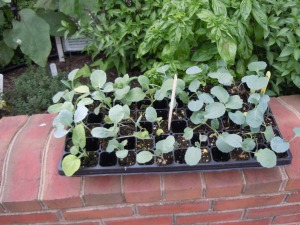Extending Your Garden Season
Get the Fall Vegetable Planting Schedule.
“Arlingwoman” is a local gardener who volunteers with Plot Against Hunger. She blogs about AFAC, the Central Library vegetable garden and Garden Talks at arlingwords.wordpress.com.
I mentioned in last week’s blog that I had started planting for fall. Just as in the transitioning spring garden, there are plants that have yielded what they will and need to be removed. You can plant in these cleared spaces.
During last Wednesday evening’s Talk in the Garden at Central Library, Don Weber, a research entomologist with USDA’s Agricultural Research Service, brought seeds, plants, and extensive knowledge.
This blog is too late to discuss replanting summer crops such as zucchini and green beans, which can be replanted throughout the summer up until mid-August. But cool weather crops such as beets, carrots, chard, and lettuces can be seeded now until mid-September. Radishes, spinach and turnips can be planted until October 1stand garlic can be seeded starting mid-September through November 1. Don starts things such as broccoli, collards, Brussels sprouts, cabbage, kale and leeks in July for planting in August as seedlings. Peas can also be seeded, but hurry—just until early September.

People were able to take away broccoli and collard seedlings for planting.
The first thing you have to do when starting the fall garden is restore nutrients the earlier crops have used up. You may recall a few weeks ago, I cleaned up my garden and added composted leaf mulch. This is good in two ways. It enriches the soil and it helps keep the ground moist. Whether you plant seeds or seedlings, you will need to keep them moist. Sprouts that come up in a dry environment won’t last long and seeds that aren’t kept moist may not germinate.
The nice thing about fall plantings is that they may have fewer insect problems. If you have had insect problems on particular plants in the garden and wish to plant the same kinds again for fall, it may be a good idea to let the area lie fallow for a couple weeks. This gives the insects time to lose hope and move on. Once you have thriving plants, you can care for them and await your harvest.
In Arlington, we usually don’t have a killing frost until mid- to late November. If the weather service reports the possibility of frost, you can still save your plants by covering them with newspaper, sheets, row cover material or some other thing you may have on hand. Just remember to remove the coverings by mid-morning so the plants don’t get over heated. In years past, I have taken fresh arugula and flowers to the Thanksgiving table from my garden. With any luck, I’ll be able to do the same this year!
Arlingwoman’s garden writings can also be found on twitter, at @Arlingwoman

